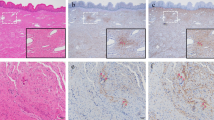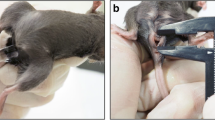Abstract
Introduction and Hypothesis
The extracellular matrix proteins collagen and elastin provide tissue strength and resilience, whereas lysyl oxidase enzymes play a major role in their stabilization. This study examines the expression and tissue localization of lysyl oxidase family proteins in the anterior vaginal wall of premenopausal women with advanced pelvic organ prolapse (POP, n = 15) and asymptomatic controls (n = 11). All women were in the proliferative phase of menstrual cycle.
Methods
Total mRNAs and proteins extracted from the vaginal tissue were examined by real-time polymerase chain reaction and immunoblotting, and tissue specimens were analyzed by immunohistochemistry.
Results
The expression of LOX, LOXL1, and LOXL3 genes as well as LOX and LOXL3 proteins were significantly reduced in POP patients (P < 0.05). Immunolocalization of LOX family proteins was confirmed in all vaginal specimens.
Conclusion
We proposed that reduced expression of LOX enzymes may result in defective assembly of pelvic tissues and development of POP.



Similar content being viewed by others
References
Hendrix SL, Clark A, Nygaaard I et al (2002) Pelvic organ prolapse in the Women's Health Initiative: gravity and gravidity. Am J Obstet Gynecol 186:1160–1166
Luber KM, Boero S, Choe JY (2001) The demographics of pelvic floor disorders: current observations and future projections. Am J Obstet Gynecol 184:1496–1501
Smith AR, Hosker GL, Warrell DW (1989) The role of partial denervation of the pelvic floor in the aetiology of genitourinary prolapse and stress incontinence of urine: a neurophysiological study. Br J Obstet Gynecol 96:24–28
Swift SE, Tate SB, Nicholas J (2003) Correlation of symptoms with degree of pelvic organ support in a general population of women: what is pelvic organ prolapse? Am J Obstet Gynecol 198:372–377
Moalli PA, Jones Ivy S, Meyn LA, Zyczynski HM (2003R) Risk factors associated with pelvic floor disorders in women undergoing surgical repair. Obstet Gynecol 101:869–874
Harris RL, Cundiff GW, Coates KW, Bump RC (1998) Urinary incontinence and pelvic organ Prolapse in nulliparous women. Obstet Gynecol 92:951–954
O'Boyle AL, Woodman PJ, O'Boyle JD, Davis GD, Swift SE (2002) Pelvic organ support in nulliparous and nonpregnant women: a case control study. Am J Obstet Gynecol 187:99–102
Norton P, Baker J, Sharp H, Warenski J (1995) Genitourinary prolapse and joint mobility in women. Obstet Gynecol 85(2):225–228
Carley ME, Schaffer J (2000) Urinary incontinence and pelvic organ prolapse in women with Marfan or Ehlers Danlos syndrome. Am J ObstetGynecol 182(5):1021–1023
Chen BH, Wen Y, Polan ML (2004) Elastolytic activity in women with stress urinary incontinence and pelvic organ prolapse. Neurourol Urodyn 23:119–126
Liu X, Zhao Y, Pawlyk B, Damaser M, Li T (2006) Failure of elastic fiber homeostasis leads to pelvic floor disorders. Am J Pathol 168(2):519–528
Kobak W, Lu J, Hardart A, Zhang C, Stanczyk F, Felix JC (2005) Expression of lysyl oxidase and transforming growth factor B2 in women with severe pelvic organ prolapse. J Rep Med 50(11):827–831
Zhang SQ, Zhang LL, Yu H (2008) Expression of elastin, lysyl oxidase and elafin in the cardinal ligament of women with pelvic organ prolapse. Zhonghua Fu Chan Ke Za Zhi 43(9):675–679
Kagan HM, Li W (2003) Lysyl oxidase: properties, specificity, and biological roles inside and outside of the cell. J Cell Biochem 88:660–672
Zhang H, Hu W, Ramirez F (1995) Developmental expression of fibrillin genes suggests heterogeneity of extra-cellular microfibrils. J Cell Biol 129:1165–1176
Nakamura T, Lozano P, Ikeda Y et al (2002) Fibulin-5/DANCE is essential for elastogenesis in vivo. Nature 415:171–175
Phillips C, Anthony F, Benyon C, Monga A (2006) Collagen metabolism in uterosacral ligaments and vaginal skin of women with uterine prolapse. Br J Obstet Gynecol 113:39–46
Chen B, Wen Y, Zhang Z, Guo Y, Warrington JA, Polan ML (2006) Microarray analysis of differentially expressed genes in vaginal tissues from women with stress urinary incontinence compared with asymptomatic women. Hum Reprod 21(1):22–29
Bump RC, Mattiasson A, Bo K et al (1996) The standardization of terminology of female pelvic organ prolapse and pelvic floor dysfunction. Am J Obstet Gynecol 175:10–17
Boreham MK, Wai CY, Miller RT, Schaffer JI, Word RA (2002) Morphometric analysis of smooth muscle in the anterior vaginal wall of women with pelvic organ prolapse. Am J Obstet Gynecol 187(1):56–63
Miller M, Vadachkoria S, Luthy DA, Williams MA (2005) Evaluation of housekeeping genes in placental comparative expression studies. Placenta 26:601–607
Vandesompele J, De Preter K, Pattyn F et al (2002) Accurate normalization of real-time quantitative RT-PCR data by geometric averaging of multiple internal control genes. Genome Biol 3(7):34
Schmittgen TD, Livak KJ (2008) Analyzing real-time PCR data by the comparative C(T) method. Nat Protoc 3(6):1101–1108
Chen B, Wen Y, Zhang Z, Wang H, Warrington JA, Polan ML (2003) Menstrual phase-dependent gene expression differences in periurethral vaginal tissue from women with stress incontinence. Am J Obstet Gynecol 189(1):89–97
Görögh T, Weise JB, Holtmeier C et al (2007) Selective upregulation and amplification of the lysyl oxidase like-4 (LOXL4) gene in head and neck squamous cell carcinoma. J Pathol 212(1):74–82
Lee JE, Kim Y (2006) A tissue-specific variant of the human lysyl oxidase-like protein 3 (LOXL3) functions as an amine oxidase with substrate specificity. J Biol Chem 281(49):37282–37290
Borel A, Eichenberger D, Farjanel J et al (2001) Lysyl oxidase-like protein from bovine aorta. Isolation and maturation to an active form by bone morphogenetic protein-1. J Biol Chem 276(52):48944–48949
Thomassin L, Werneck CC, Broekelmann TJ et al (2005) The pro-regions of lysyl oxidase and lysyl oxidase-like 1 are required for deposition onto elastic fibers. J Biol Chem 280(52):42848–42855
Shanley CJ, Gharaee-Kermani M, Sarkar R, Welling TH, Kriegel A, Ford JW, Stanley JC, Phan SH (1997) Transforming growth factor-beta 1 increases lysyl oxidase enzyme activity and mRNA in rat aortic smooth muscle cells. J Vasc Surg 25(3):446–452
Nellaiappan K, Risitano A, Liu G, Nicklas G, Kagan HM (2000) Fully processed lysyl oxidase catalyst translocates from the extracellular space into nuclei of aortic smooth-muscle cells. J Cell Biochem 79:576–582
Acknowledgements
The study funding was provided by the Research Fund, Department of Obstetrics and Gynecology, Mount Sinai Hospital, Toronto. There is no conflict of interest to be disclosed.
We thank Dr. V. Miranda for assisting us in the statistical analysis.
Conflicts of interest
None.
Author information
Authors and Affiliations
Corresponding author
Electronic supplementary material
Below is the link to the electronic supplementary material.
Supplemental Fig. 1
Double immunostaining for CD68 and LOXL1 proteins. Immunofluorescence microscopy stained with antibodies against LOXL1 (C, red color), CD68 (B, green color), and nuclear staining (A, blue color). Coexpression of LOXL1 and CD68 by the same cell is indicated by yellow color (overlap of green and red). Magnification is ×400; scale bar = 25 μm (GIF 22 kb)
Rights and permissions
About this article
Cite this article
Alarab, M., Bortolini, M.A., Drutz, H. et al. LOX family enzymes expression in vaginal tissue of premenopausal women with severe pelvic organ prolapse. Int Urogynecol J 21, 1397–1404 (2010). https://doi.org/10.1007/s00192-010-1199-9
Received:
Accepted:
Published:
Issue Date:
DOI: https://doi.org/10.1007/s00192-010-1199-9




